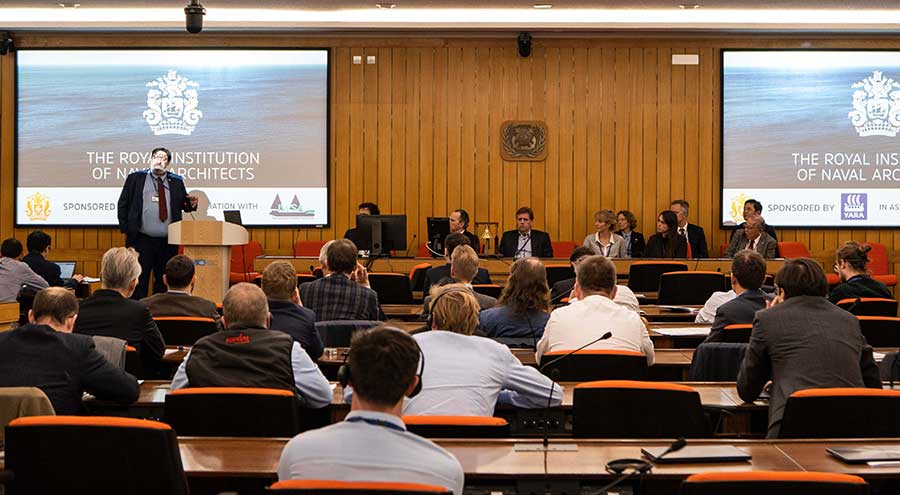Wind Propulsion 2023 conference brings together top speakers at IMO
The Royal Institution of Naval Architects held its annual Wind Propulsion conference on the 16-17 February 2023. The event took place at the headquarters of the International Maritime Organisation in London, representing the first time that RINA has organised an event at this location.
The event, sponsored by Yara International and the International Windship Association, was attended by over 100 people and included delegates from a range of different organisations and countries at the forefront of wind-assisted propulsion systems (WAPS) technology. The speakers over the conference’s two-day schedule represented organisations from naval architecture firms and ship to designers and research organisations. The delegates also took part in a lively debate each day which allowed for discussion on multiple topics related to wind propulsion. There was also time for crucial networking amongst industry professionals, allowing individual attendees to share ideas with each other in a more informal setting during coffee and lunch breaks in the IMO’s lounge.
The papers presented during the course of the conference there were topics ranging from theoretical ideas, to the more practical. Amongst these were things such as the use of CFD in predicting performance of WAPS technology and the use of manoeuvre simulations, as well empirical methods for data collection. These included the team at bound4blue, which has developed the eSAIL. Taking inspiration from the Turbovoile concept, the eSAIL is an autonomous suction sail that combines the positive features of a conventional wingsail but uses an active boundary layer control techniques to prevent flow detachment, thus achieving extraordinarily high values of lift coefficients. This results in a smaller size and lower weight sails for equivalent savings. Using results from CFD the paper showcased bound4blue’s journey in using CFD to design the eSAIL, showing details at every step of the way with an increase in performance of up to 20% when compared to the Turbovoile.
Highlighting wind propulsion technology’s applications in the field of passenger cruise ships the team from Chantiers de l’Atlantique (CdA) likewise offered some key insights into how this area of shipping could benefit in the future. CdA’s team presented their large sailing cruise ship concept design, Silenseas, which would allow cruise vessels to reduce their GHG emissions up to 45% compared to similar conventional ships and is transferable large vessels, resulting in even larger potential energy savings.
Another paper of note presented was from the team at RISE Maritime, who’s work concerned the development of standardised ways to express the technical performance of wind propulsion technologies. As the wind propulsion community has not yet agreed on common key performance indicators (KPI), this makes comparison between different technologies difficult. Using an example ship of a 5,000dwt general cargo carrier with a length of 90m, RISE analysed different WAPS technology and how it impacted vehicle performance. The resulting research presented by RISE Maritime at the conference is a crucial step towards regulation within the industry. Also presented during the conference was important work by XP Sea and Semantic TS relating to the effects of underwater radiated noise (URN) on marine life and the possible applications of wind propulsion technologies to mitigate this. Crucially this study highlighted that a WAPS cargo vessel received 40% of its propulsion from wind will reduce significantly the disturbance of marine mammals’ communication while keeping the same speed as a vessel powered 100% by conventional propulsion.
A further illustration of the practical application of wind propulsion technologies on an existing vessel was presented by the team from Ouchi Ocean Consultant Inc and Mitsui O.S.K. Lines Ltd, whose “Wind Hunter” design is a zero-emission cargo ship powered by wind and hydrogen energy. The research presented on the vessel demonstrated that when a sailing ship with large rigid sails navigates in a sufficiently windy area, the thrusts from sails are strong enough drive the ship at an adequate speed and rotate a large underwater turbine. Thus, generating electricity for the water electrolysis to generate hydrogen onboard. The Wind Hunter design is equipped with the Wind Challenger sail, a large rigid wing sail capable of powering a large merchant ship with the potential to run the ship at the cruising speed and generate proper amount of hydrogen which is made from kinetic energy of the wind via electricity.
Many more papers were also presented during the conference which will be made available to RINA members, showcasing the cutting edge of industry research in wind propulsion technology. Following the success of the conference at the IMO RINA looks forward to an exciting year showcasing work by individuals and organisations in the naval architecture field.




